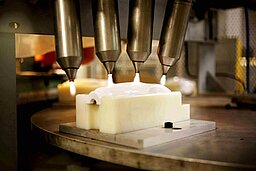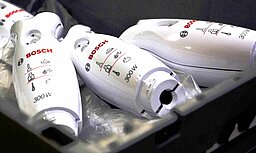Success Story with BSH Bosch und Siemens Hausgeräte
For a producer, there is certainly no greater satisfaction than knowing about the high quality and durability of their own product. We are pleased to testify these features to Plasmatreat after our long experience with the Openair-Plasma® process.
The Bosch und Siemens Hausgeräte GmbH - competence center for small motor-driven appliances is located in Nazarje, Slovenia. It is responsible within the BSH Group for the development and production, the quality and worldwide sales of these products. The production of immersion mixers makes up the largest portion of the production.
For this product we built a new production line in 1999 with the objective to increase the capacity while reducing cost at the same time. With these considerations in mind, the previously processed, expensive ABS plastics was to be replaced, among others, by equally high-quality but lower-priced PP (polypropylene). There was only one problem: the difficult printability of PP. To enable printing of the rounded off handles of the immersion mixer in tampon print, a previous optimal pretreatment of the polypropylene is mandatory since without microfine cleaning and high activation of the plastic surface a strong, long-term stable adhesion of the printing ink cannot be achieved.
Pretreatment with corona, flame or low pressure plasma would have been conceivable on principle but these methods were not suited for our product given the particularly sensitive high-gloss surfaces. A corona treatment would have left "crows feet", i.e. mat lines on the plastics which would have remained visible while printing. In the case of a flame method, the gas would form cloudy, mat surfaces with the same negative effect on the appearance. A plasma treatment under low pressure would have necessitated a laborious vacuum chamber system on the one hand and could have hardly been integrated into the line on the other.

We found the solution to our problem in the Openair-Plasma® technology. The then young, innovative method was presented to us by the female engineer, Irena Uranjek, with whose company, Rogac Plus, we had already cooperated at the time. The test series revealed that this plasma technique not only provided the best adhesion results but was also the only method to leave no visible traces on white and very bright polypropylene. Moreover, the system had been developed for automatic production and could be readily employed by us inline. When black PP was introduced for our product, BSH additionally purchased from Plasmatreat the RD1004 rotational-nozzle system which now also imparts a perfect appearance to dark, high-gloss material.

For more than 10 years the original Plasmatreat Openair-Plasma® unit has been in continuous operation. The system has been operating 24/7 during a 3-shift cycle without failure, and always with the same process safety and effectiveness as in the beginning. To date more than 10,500,000 immersion blenders have been pretreated with this plasma unit at BSH Nazarje.

